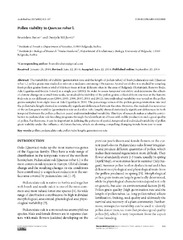Приказ основних података о документу
Pollen viability in Quercus robur L.
| dc.creator | Batos, Branislava | |
| dc.creator | Miljković, Danijela | |
| dc.date.accessioned | 2017-11-23T11:31:42Z | |
| dc.date.available | 2017-11-23T11:31:42Z | |
| dc.date.issued | 2017 | |
| dc.identifier.issn | 0354-4664 | |
| dc.identifier.uri | http://www.doiserbia.nb.rs/Article.aspx?ID=0354-46641600084B | |
| dc.identifier.uri | http://www.serbiosoc.org.rs/arch/index.php/abs/article/view/50 | |
| dc.identifier.uri | https://radar.ibiss.bg.ac.rs/handle/123456789/2680 | |
| dc.description.abstract | The variability of viability (germination rate and the length of pollen tubes) of fresh pedunculate oak (Quercus robur L.) pollen grains was studied in vitro on a medium containing 15% sucrose. Spatial variability was studied by sampling fresh pollen grains from a total of thirteen trees at four different sites in the area of Belgrade (Košutnjak, Banovo Brdo, Ada Ciganlija and Bojcin Forest) in a single year (2011). In order to assess temporal variability and determine the effects of climate change on a small time scale, we studied the viability of the pollen grains collected from one tree at the Banovo Brdo site in six different years (2004, 2005, 2006, 2007, 2011 and 2012). Interindividual variability was tested on the pollen grains sampled from eight trees at Ada Ciganlija in 2004. The percentage values of the pollen grain germination rate and the pollen tube length showed no statistically significant differences between the sites. However, the studied characteristics of the pollen grain viability (germination rate and pollen tube length) showed statistically significant differences in both temporal (between the pollen collection years) and interindividual variability. This type of research makes a valuable contribution to pedunculate oak breeding programs through the identification of trees with stable production and a good quality of pollen. Furthermore, it can be important in defining the patterns of spatial, temporal and individual variability of pollen grain viability under the influence of climate factors, which are showing compelling changing trends from year to year. | en |
| dc.rights | openAccess | |
| dc.rights.uri | https://creativecommons.org/licenses/by-nc-nd/4.0/ | |
| dc.source | Archives of Biological Sciences | |
| dc.subject | Density | |
| dc.subject | Fecundity | |
| dc.subject | Vegetative parameters | |
| dc.subject | Velvetleaf | |
| dc.title | Pollen viability in Quercus robur L. | en |
| dc.type | article | |
| dc.rights.license | BY-NC-ND | |
| dcterms.abstract | Батос, Бранислава; Миљковић, Данијела; | |
| dc.rights.holder | © 2017 by the Serbian Biological Society | |
| dc.citation.issue | 1 | |
| dc.citation.volume | 69 | |
| dc.identifier.doi | 10.2298/ABS160121084B | |
| dc.identifier.scopus | 2-s2.0-85015047378 | |
| dc.identifier.wos | 000396702900012 | |
| dc.citation.apa | Batos, B., & Miljković, D. (2017). Pollen viability in Quercus robur L. Archives of Biological Sciences, 69(1), 111–117. | |
| dc.citation.vancouver | Batos B, Miljković D. Pollen viability in Quercus robur L. Arch Biol Sci. 2017;69(1):111–7. | |
| dc.citation.spage | 111 | |
| dc.citation.epage | 117 | |
| dc.type.version | publishedVersion | en |
| dc.identifier.fulltext | https://radar.ibiss.bg.ac.rs/bitstream/id/3526/bitstream_3526.pdf | |
| dc.citation.rank | M23 |

